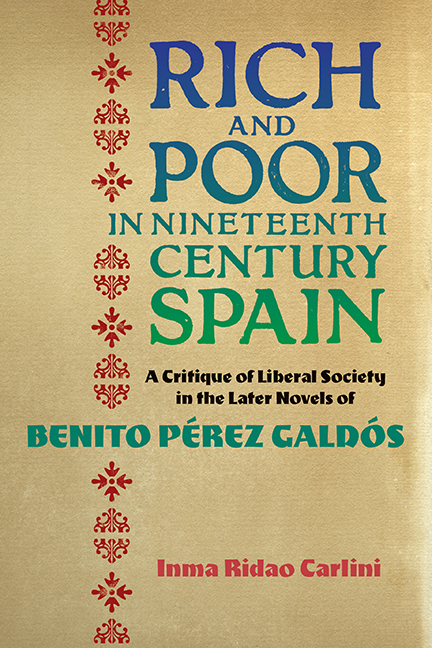 Rich and Poor in Nineteenth-Century Spain
Rich and Poor in Nineteenth-Century Spain Book contents
- Frontmatter
- Contents
- Acknowledgements
- Abbreviations
- Introduction
- 1 Changing Fortunes and the Financial World in Galdós's Lo prohibido
- 2 From Usurer to Marqués: Lending and Social Advancement in the Torquemada Novels
- 3 Revolution and the Politics of Religion in Ángel Guerra
- 4 The cuestión social in Misericordia
- Afterword
- Bibliography
- Index
1 - Changing Fortunes and the Financial World in Galdós's Lo prohibido
Published online by Cambridge University Press: 05 July 2018
- Frontmatter
- Contents
- Acknowledgements
- Abbreviations
- Introduction
- 1 Changing Fortunes and the Financial World in Galdós's Lo prohibido
- 2 From Usurer to Marqués: Lending and Social Advancement in the Torquemada Novels
- 3 Revolution and the Politics of Religion in Ángel Guerra
- 4 The cuestión social in Misericordia
- Afterword
- Bibliography
- Index
Summary
The themes of wealth, credit and speculation are central to Lo prohibido (1884–85), a novel whose narrative, covering the period from 1880 to 1884, is strictly contemporary. Blanco, in her analysis of this novel, focuses on Galdós's treatment in it of the socio-economic changes that resulted from the nineteenthcentury capitalist expansion in Spain. In particular, she stresses Galdós's portrayal of the bourgeoisie as the new but already well-established dominant class of Restoration society. In her view, Galdόs offers in Lo prohibido a synchronic study of this financial elite, without analysing how it came about. In the Torquemada novels, by contrast, the perspective is diachronic, one that looks at the development of this class from its rise to its zenith (Blanco 1983: 61–2). Nonetheless, it is important to note that the narrator in Lo prohibido gives extensive details about the origins of the great fortunes that populate this novel, which often go back to the 1850s and 1860s. Moreover, the picture that emerges from Lo prohibido is not of a well-established and well-defined bourgeois class but of a hybrid and unstable one, in which social mobility goes up as well as down. This chapter aims to contribute further to a socio-economic reading of Lo prohibido by analysing Galdós's depiction of the money elite of the 1880s as representative of the unbalanced and fragile capitalist system that developed in Spain from the 1830s onwards.
As Whiston points out, the early 1880s, the years in which Lo prohibido is set, were particularly active for the economic sector in Madrid. There was a significant increase in the number of building licences granted, and also a consistent rise in the value of stock-market shares. This upward trend in stockmarket securities allowed bondholders to double their money in a very short period of time. The boom lasted until the summer of 1883, the year before Galdόs started to write Lo prohibido, when a sharp fall in prices caused many investors to suffer great losses (Lo prohibido: 95–6). As Tuñόn de Lara notes, the first decade of the Restoration also saw a great increase in the circulation of fiduciary money, particularly during the years 1881 and 1882 (Tuñόn de Lara 1960, II: 41–2).
- Type
- Chapter
- Information
- Rich and Poor in Nineteenth-Century SpainA Critique of Liberal Society in the Later novels of Benito Pérez Galdós, pp. 11 - 54Publisher: Boydell & BrewerPrint publication year: 2018


